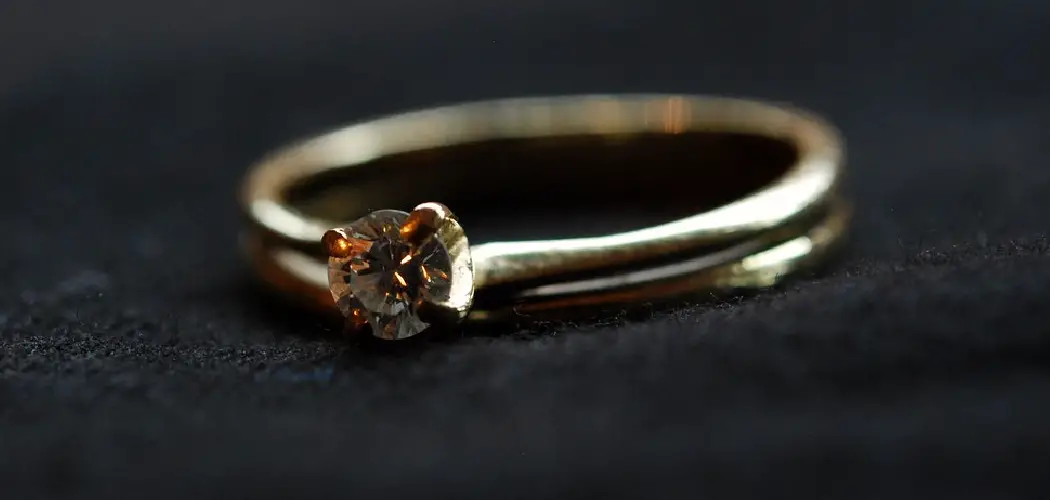An engagement ring is not just a symbol of commitment; it’s a piece of jewelry that holds profound emotional significance. But what if the ring doesn’t fit perfectly? Thankfully, resizing a ring to a smaller size is a common request that skilled jewelers can perform with precision.
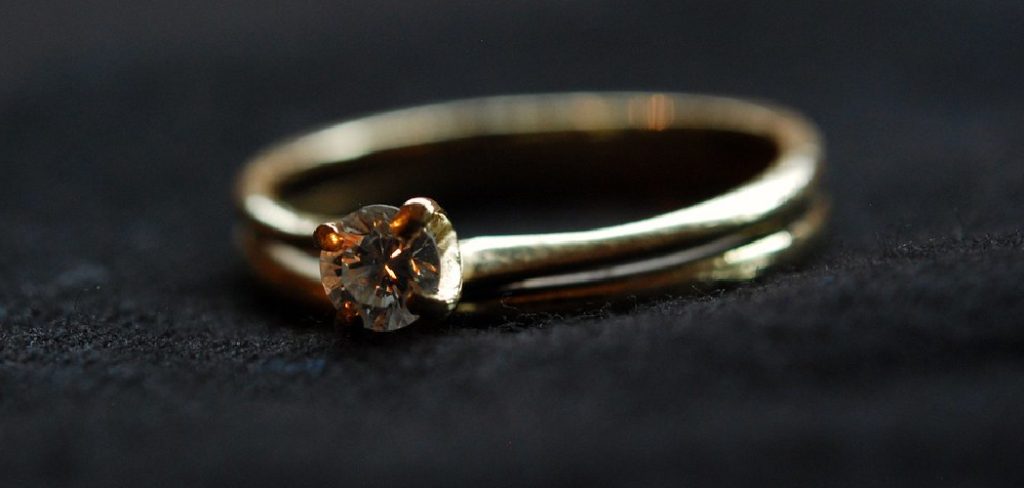
In this guide on how to make engagement ring smaller, we will explore various methods and considerations for making an engagement ring smaller, ensuring your treasured token of love fits comfortably and securely on your finger.
What is Ring Resizing?
Ring resizing is the process of altering the size of a ring. This includes making a ring larger or smaller, depending on one’s desired fit. When it comes to engagement ring resizing, the focus is on making a ring smaller.
For engagement rings, it’s important to get the right fit as you will be wearing them every day. A loose ring can easily slip off your finger, while a tight ring can cause discomfort and potentially harm your finger. Therefore, resizing an engagement ring is a crucial step in ensuring its longevity and comfort.
Why Resize an Engagement Ring?
There are various reasons for wanting to resize an engagement ring. The most common reason is that the original size of the ring no longer fits comfortably due to weight changes or fluctuations in temperature, which can cause fingers to swell or shrink.
Additionally, some people may have inherited a family heirloom ring that isn’t their size, and resizing it allows them to wear and cherish the sentimental piece. Others may want to pass down their own engagement rings to future generations, making resizing necessary for a perfect fit.
Considerations Before Resizing
Before jumping into resizing your engagement ring, there are a few factors you should consider:
Type of Metal:
Resizing can be more challenging with certain metals such as titanium or tungsten, which are more durable and difficult to work with. On the other hand, softer metals like gold and silver are easier to resize.
Type of Stone:
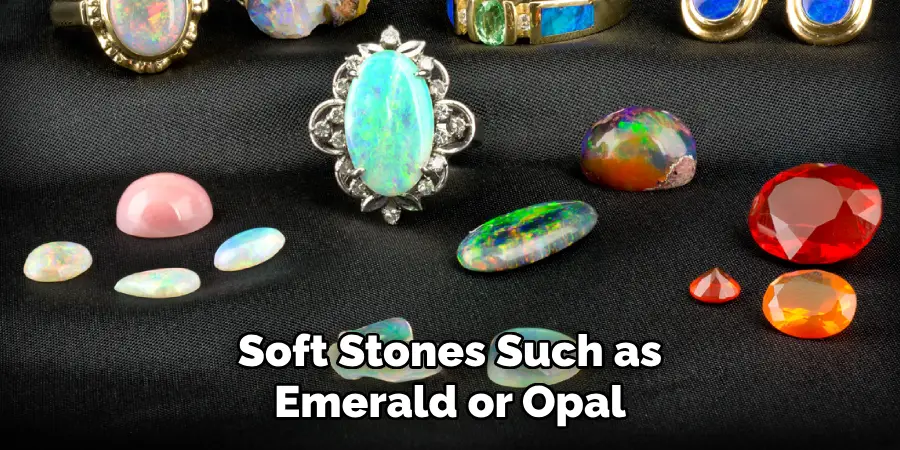
Some gemstones, like soft stones such as emerald or opal, may be more prone to damage during the resizing process. It’s crucial to consult with a professional jeweler who has experience working with different types of gemstones.
Style of Ring:
Resizing a simple band will be easier than resizing one with intricate details or engraving. It’s important to consider the design of your engagement ring and how it may affect the resizing process.
Cost:
Resizing an engagement ring can be costly, depending on the type of metal and stone, as well as the complexity of the resizing process. It’s essential to discuss pricing with a jeweler beforehand to avoid any surprises.
10 Simple Step-by-step Guides on How to Make Engagement Ring Smaller
Step 1: Determine Your Current Ring Size
The first step is to determine your current ring size, which can be done by visiting a jeweler or using a ring sizer at home. This will help you understand how much your ring needs to be resized.
You can also measure the inside diameter of your ring in millimeters to determine its size. But keep in mind that this method may not be as accurate. It’s always best to consult with a professional jeweler for an accurate measurement.
Step 2: Find a Trustworthy Jeweler
The next step is to find a trustworthy jeweler who has experience with resizing engagement rings. Ask for recommendations from friends or family, read reviews online, and inquire about their experience working with different types of metals and stones.
The jeweler should also be able to provide you with a quote for the resizing process. If possible, choose a jeweler who offers insurance for the ring during the resizing process to avoid any potential damage. But keep in mind that this may come at an additional cost.
Step 3: Decide on the Amount of Resizing
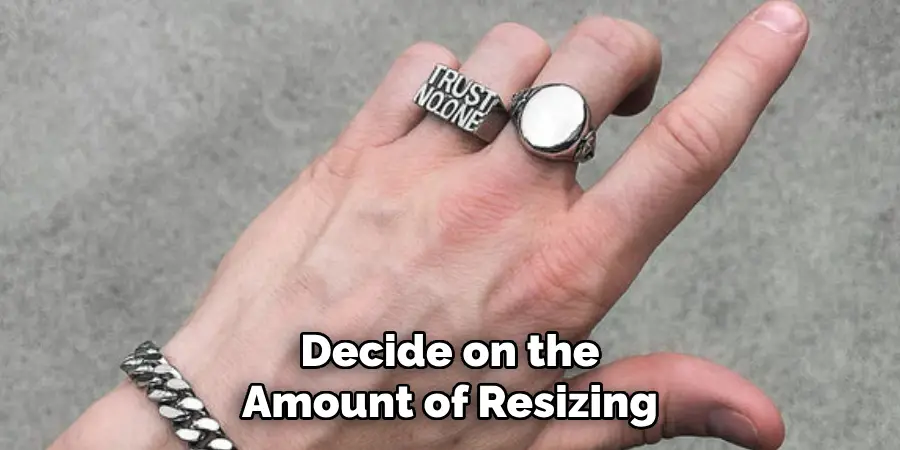
Based on your current ring size and desired fit, decide on the amount of resizing needed. A general rule of thumb is to resize no more than two sizes up or down to avoid altering the integrity of the ring. Any major adjustments beyond the two sizes can affect the design and structure of the ring.
There may also be limitations based on the type of metal and stone. It’s crucial to discuss this with your jeweler before proceeding. The jeweler may also suggest alternative methods, such as adding sizing beads or a ring guard instead of resizing.
Step 4: Consider Temporary Sizing Options
If the ring only needs a slight adjustment, you may want to consider temporary sizing options such as sizing bead inserts or a ring guard. These options can be easily removed if you decide to resize the ring in the future, and they are less invasive than resizing. You can discuss these options with your jeweler to see if they are suitable for your ring.
The downside is that they may not be as secure as resizing, and the ring may still feel slightly loose or tight. It’s important to weigh the pros and cons before deciding on a temporary sizing option.
Step 5: Get a Quote from Your Jeweler
Discuss the desired amount of resizing and an estimated cost with your jeweler. The pricing will vary depending on the type of metal, stone, and complexity of the resizing process. It’s essential to get a quote beforehand to avoid any unexpected costs. You can also inquire about any additional fees, such as insurance or rush fees.
The jeweler may also give you a timeline for when the resizing will be completed. It’s important to keep in mind that resizing may take a few days or even weeks, depending on the workload of the jeweler.
Step 6: Decide on Any Changes to the Ring
If you’ve inherited an engagement ring or have sentimental attachments to its design, make sure to discuss any changes with your jeweler beforehand. For example, if you want to add or remove an engraving or change the setting of the stone, this can also be done during the resizing process.
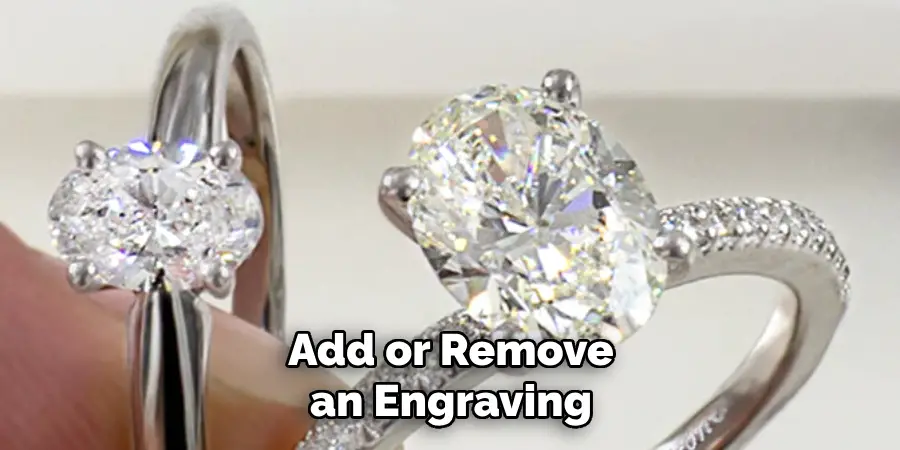
However, keep in mind that these changes may affect the pricing and timeline for resizing. You can also ask your jeweler for suggestions on how to enhance or update the ring’s design while resizing. The goal is to create a ring that you’re happy with and will wear comfortably for years to come.
Step 7: Hand Over the Ring
Once you’ve discussed all the details with your jeweler, it’s time to hand over the ring. Make sure to get a receipt or written agreement stating the resizing process, timeline, and cost. This will serve as proof of the transaction and protect both parties in case any issues arise.
It’s also a good idea to take photos of the ring before handing it over so you have a reference point if needed. The jeweler may also ask for a deposit before starting the resizing process. It’s important to understand the terms and conditions of the jeweler before proceeding.
Step 8: Wait Patiently
Now comes the hardest part waiting for your ring to be resized. Try not to rush the process or constantly check in. Trust that your jeweler is taking good care of your ring and will return it to you as soon as possible. Keep in mind that depending on the complexity of the resizing, it may take a few days or even weeks.
If you have any concerns or questions, don’t hesitate to reach out to your jeweler for updates. You can also inquire about the status of your ring as per the agreed timeline. It’s important to maintain open communication with your jeweler throughout the process. The last thing you want is to rush the process and end up with a poorly done resizing job.
Step 9: Try on the Ring and Make Sure it Fits
Once you receive your resized ring, try it on to make sure it fits comfortably. It should feel snug but not tight on your finger, and you shouldn’t have any difficulty taking it off or putting it on. If the ring still doesn’t fit properly, make sure to discuss this with your jeweler to see if any further adjustments can be made.
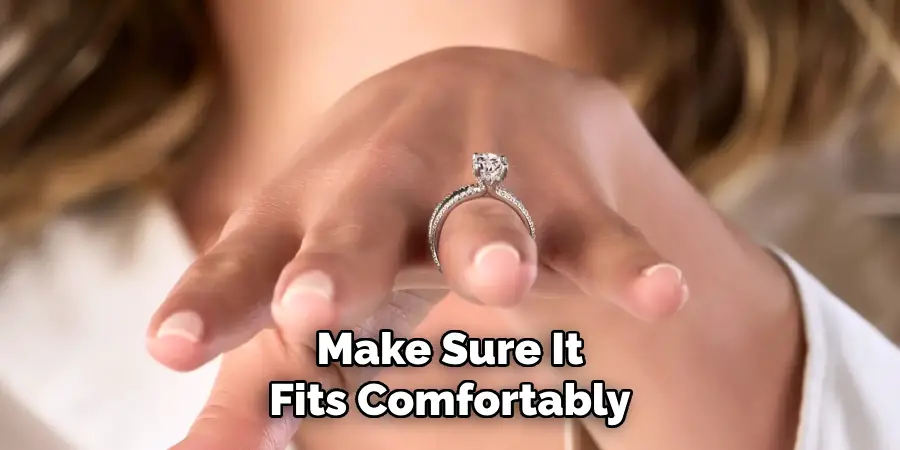
Keep in mind that resizing may not always result in a perfect fit due to the nature of the process. But the goal is to have a ring that you can wear comfortably and confidently. The final step is to enjoy your newly resized engagement ring and cherish it for years to come. With proper care, it will remain a symbol of love and commitment for a lifetime.
Step 10: Take Care of Your Resized Ring
After all the hard work, it’s essential to take care of your newly resized engagement ring. Make sure to follow any maintenance or cleaning instructions provided by your jeweler to ensure the longevity of your ring. Avoid exposing it to harsh chemicals or wearing it during activities that may cause damage.
With proper care and upkeep, your resized ring will continue to shine and hold its sentimental value for many years to come. And if you ever need to resize again in the future, you now know the steps to take. So go ahead, wear your ring with pride and show off your unique love story to the world. Don’t forget to pass on this knowledge to others who may need it in the future.
Following these steps on how to make engagement ring smaller and taking proper care of your resized engagement ring will ensure that it remains a symbol of love and commitment for years to come. Remember to cherish the memories attached to the ring and wear it with pride. Congratulations on your newly resized ring, and best wishes for a lifetime of happiness! Happy resizing!
Tips and Best Practices for Successful Ring Resizing
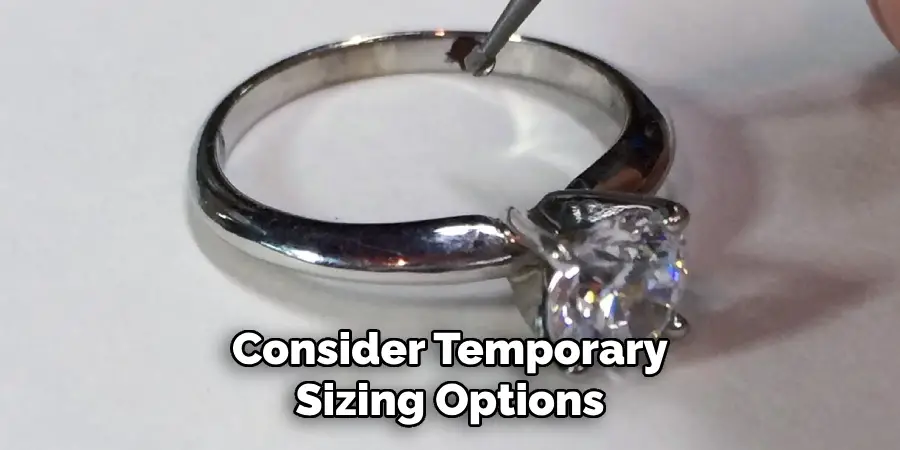
- Always Consult With a Professional Jeweler Before Making Any Changes to Your Engagement Ring.
- Consider Temporary Sizing Options if You’re Unsure About Permanent Resizing.
- Get a Quote From Your Jeweler Beforehand to Avoid Any Unexpected Costs.
- Discuss Any Desired Changes to the Ring’s Design With Your Jeweler Before Resizing.
- Maintain Open Communication With Your Jeweler Throughout the Resizing Process.
- Take Care of Your Newly Resized Ring by Following Maintenance and Cleaning Instructions Provided by Your Jeweler.
- Avoid Exposing the Ring to Harsh Chemicals or Activities That May Cause Damage.
- Remember to Cherish the Memories Attached to the Ring and Wear It With Pride.
- Pass on This Knowledge to Others Who May Need It in the Future.
- If Necessary, Consider Resizing Again in the Future to Ensure a Comfortable and Proper Fit. So Go Ahead, Wear Your Ring With Pride and Show Off Your Unique Love Story to the World. Happy Resizing!
Common Mistakes to Avoid in Ring Resizing
- Rushing the Process and Not Giving Enough Time for Proper Resizing.
- Not Consulting With a Professional Jeweler Before Making Changes to the Ring.
- Not Understanding the Pricing and Terms of the Jeweler Beforehand.
- Requesting Last Minute Changes or Updates During the Resizing Process.
- Neglecting to Get a Written Agreement or Receipt From the Jeweler.
- Not Communicating with the Jeweler About Any Concerns or Updates.
- Forgetting to Take Proper Care of the Resized Ring After It’s Returned.
- Not Passing on This Knowledge to Others Who May Need it in the Future.
Avoiding these common mistakes will help ensure a successful and satisfactory ring resizing experience. Remember, proper communication and care are key to achieving a perfectly resized ring that you can proudly wear for years to come.
Advanced Techniques for Specialized Ring Resizing
While the basic steps of ring resizing are suitable for most cases, there may be some instances where specialized techniques are needed. For example, if the ring has intricate designs or a complex setting, traditional resizing methods may not be feasible.
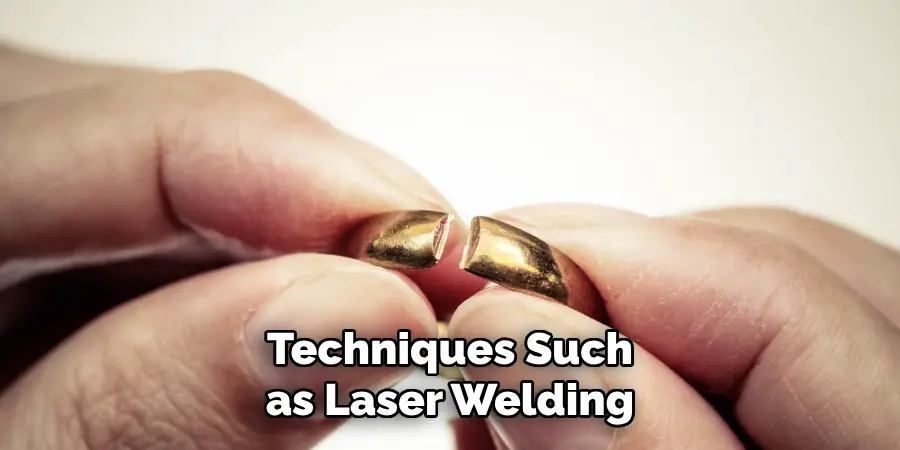
In these situations, advanced techniques such as laser welding or adding gold beads to the ring’s shank may be necessary. It’s essential to consult with a professional jeweler who has experience in these specialized techniques to ensure the best results for your unique ring.
Remember, every ring is different, and there is no one-size-fits-all approach to resizing. So, if you have a special or unique engagement ring, make sure to discuss your options with your jeweler beforehand. With the right expertise and techniques, even the most challenging resizing jobs can be successfully completed.
Troubleshooting Issues with Ring Resizing
In some cases, despite following all the necessary steps and precautions, there may be issues with the resizing process. Some common problems that may arise include:
- The Resized Ring is Too Loose or Tight.
- The Ring’s Design or Setting Has Been Altered During Resizing.
- The Metal Has Become Weakened or Distorted During the Resizing Process.
- The Ring is Not Symmetrical or Has an Uneven Appearance.
If you encounter any of these issues, it’s essential to communicate with your jeweler and discuss possible solutions. In some cases, they may be able to make further adjustments or offer alternative solutions. Remember, resizing is not an exact science, and there may be some trial and error involved in achieving the perfect fit for your ring.
With patience and proper communication, any issues can be resolved to ensure your satisfaction with the final result.
Frequently Asked Questions
Q: How Long Does It Take to Resize an Engagement Ring?
A: The duration of resizing may vary depending on the complexity and workload of the jeweler. It can take a few days to a few weeks. You can discuss the estimated timeline with your jeweler before handing over the ring. It’s essential to be patient and avoid rushing the process for a successful resizing result.
Q: How Much Does It Cost to Resize an Engagement Ring?
A: The cost of resizing depends on various factors such as the type of metal, stone, and complexity of the resizing process. It’s important to get a quote from your jeweler beforehand to avoid any unexpected costs. You can also inquire about any additional fees, such as insurance or rush fees.
Q: Can I Resize My Engagement Ring Multiple Times?
A: Yes, it is possible to resize a ring multiple times. However, frequent resizing may affect its structural integrity and cause damage in the long run. It’s best to consult with your jeweler before making any significant changes to the ring’s size or design.
Q: Can I Make Big Changes to My Ring During Resizing?
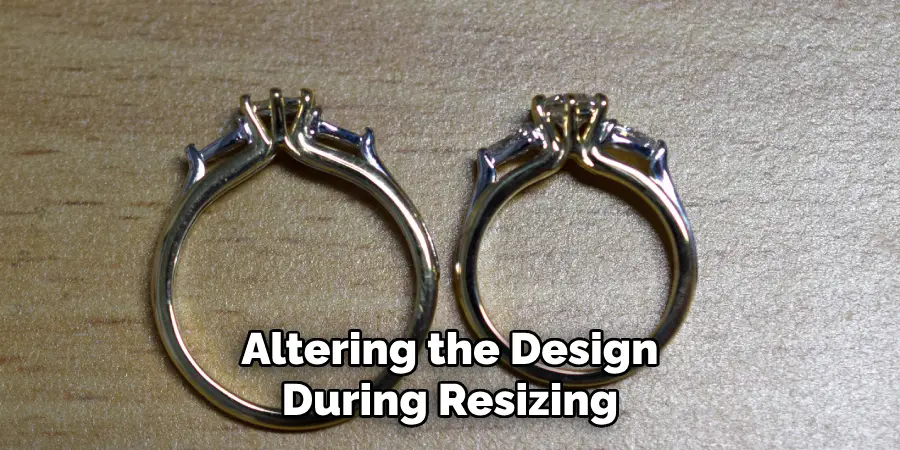
A: Yes, you can make changes such as adding or removing engravings, changing the setting of the stone, and altering the design during resizing. However, keep in mind that these changes may affect the cost and timeline of resizing. It’s essential to discuss all the details with your jeweler beforehand. You can also ask for recommendations on how to enhance the ring’s design while resizing.
Conclusion
Finding the perfect fit for an engagement ring is essential for comfort and security. Whether you choose professional resizing, a ring guard, or another method to make your ring smaller, it’s important to consider the ring’s material, style, and any sentimental value it may hold.
Proper sizing ensures that this symbol of love and commitment can be worn with pride and without worry for many years to come. Always consult with a professional jeweler to determine the best option for your specific ring. Thanks for reading this article on how to make engagement ring smaller.

